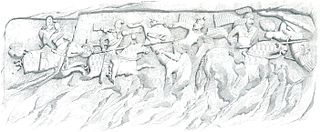The 150s decade ran from January 1, 150, to December 31, 159.
The 160s decade ran from January 1, 160, to December 31, 169.
The 180s decade ran from January 1, 180, to December 31, 189.
The 190s decade ran from January 1, 190, to December 31, 199.
Year 138 (CXXXVIII) was a common year starting on Tuesday of the Julian calendar. At the time, it was known as the Year of the Consulship of Niger and Camerinus. The denomination 138 for this year has been used since the early medieval period, when the Anno Domini calendar era became the prevalent method in Europe for naming years.
The 270s decade ran from January 1, 270, to December 31, 279.
Year 168 (CLXVIII) was a leap year starting on Thursday of the Julian calendar. At the time, it was known as the Year of the Consulship of Apronianus and Paullus. The denomination 168 for this year has been used since the early medieval period, when the Anno Domini calendar era became the prevalent method in Europe for naming years.
Year 169 (CLXIX) was a common year starting on Saturday of the Julian calendar. At the time, it was known as the Year of the Consulship of Senecio and Apollinaris. The denomination 169 for this year has been used since the early medieval period, when the Anno Domini calendar era became the prevalent method in Europe for naming years.
The 220s decade ran from January 1, 220, to December 31, 229.
The 240s decade ran from January 1, 240, to December 31, 249.
Year 241 (CCXLI) was a common year starting on Friday of the Julian calendar. At the time, it was known as the Year of the Consulship of Gordianus and Pompeianus by the Romans. The denomination 241 for this year has been used since the early medieval period, when the Anno Domini calendar era became the prevalent method in Europe for naming years.
Year 252 (CCLII) was a leap year starting on Thursday of the Julian calendar. At the time, it was known as the Year of the Consulship of Trebonianus and Volusianus. The denomination 252 for this year has been used since the early medieval period, when the Anno Domini calendar era became the prevalent method in Europe for naming years.

Year 193 (CXCIII) was a common year starting on Monday of the Julian calendar. At the time, it was known as the Year of the Consulship of Sosius and Ericius. The denomination 193 for this year has been used since the early medieval period, when the Anno Domini calendar era became the prevalent method in Europe for naming years.

This article concerns the period 109 BC – 100 BC.
This article concerns the period 119 BC – 110 BC.

Year 224 (CCXXIV) was a leap year starting on Thursday of the Julian calendar. At the time, it was known as the Year of the Consulship of Iulianus and Crispinus. The denomination 224 for this year has been used since the early medieval period, when the Anno Domini calendar era became the prevalent method in Europe for naming years.
Year 91 BC was a year of the pre-Julian Roman calendar. At the time it was known as the Year of the Consulship of Philippus and Caesar and the Second Year of Zhenghe. The denomination 91 BC for this year has been used since the early medieval period, when the Anno Domini calendar era became the prevalent method in Europe for naming years.

Annia Aurelia Galeria Lucilla or Lucilla was the second daughter of Roman emperor Marcus Aurelius and Roman empress Faustina the Younger. She was the wife of her father's co-ruler and adoptive brother Lucius Verus and an elder sister to later emperor Commodus. Commodus ordered Lucilla's execution after a failed assassination and coup attempt when she was about 33 years old.

Year 222 (CCXXII) was a common year starting on Tuesday of the Julian calendar. In the Roman Empire, it was known as the Year of the Consulship of Antoninus and Severus. The denomination 222 for this year has been used since the early medieval period, when the Anno Domini calendar era became the prevalent method in Europe for naming years.

Bruttia Crispina was Roman empress from 178 to 191 as the consort of Roman emperor Commodus. Her marriage to Commodus did not produce an heir, and her husband was instead succeeded by Pertinax.





